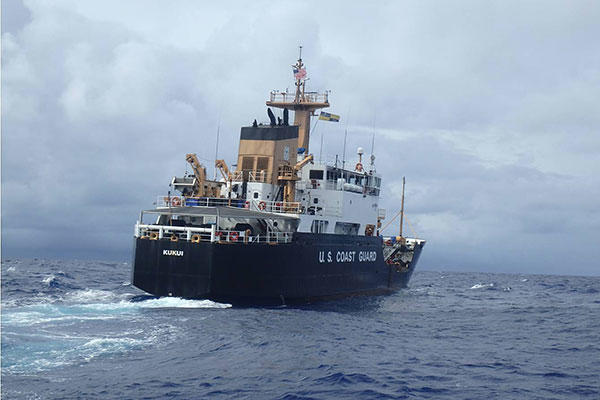HONOLULU — The USCGC Kukui (WLB 203) crew returned home to Honolulu Monday after a 42-day patrol of the Western and Central Pacific to enforce federal fishing regulations of highly migratory fish stocks such as tuna while strengthening relations with Pacific partners.
"Kukui’s crew is proud to be part of the U.S. Coast Guard and its mission toward a prosperous, secure and stable Pacific fishing industry," said Lt. Cmdr. Brendan Harris, commanding officer of the Kukui. "The joint work we do under our bi-lateral agreements with Pacific nations like Tuvalu and the Cook Islands have increased the overall number of boardings we are able to conduct and our enforcement presence in the Pacific where these highly migratory fish stocks are threatened."
Enforcement officials from Tuvalu, Australia and the Cook Islands assisted Kukui during this patrol. Their presence was highly instrumental in facilitating communications between the Coast Guard and various officials as well as with foreign fishing vessels encountered during this deployment. As a result, Kukui's crew completed 16 fisheries enforcement boardings within the high seas and foreign exclusive economic zones under the authority of the Western and Central Pacific Fisheries Commission (WCPFC) and the bilateral agreements with the countries of Tuvalu and the Cook Islands. Types of vessels inspected include commercial fishing vessels, long liners and purse seiners.
WCPFC is comprised of 26 nations that regulate fisheries in the high seas regions of the Pacific. Within these partnerships, the U.S. Coast Guard’s 14th District works closely to promote the conservation and sustainable use of migratory fish stocks.
The Coast Guard executes bilateral agreements with nine Pacific Island countries: Tonga, Palau, the Federated States of Micronesia, and Republic of Marshall Islands, the Cook Islands, Kiribati, Samoa, Republic of Nauru and the government of Tuvalu. This body of agreements, commonly known as shiprider agreements, allows the service to engage in bilateral maritime operations where a law enforcement officer rides aboard a Coast Guard platform, usually a cutter, enforces their own nation’s laws within their own EEZ with the Coast Guard’s support. This allows for capacity building, training, joint operations and the safeguarding of highly migratory fish stocks in the Pacific that may enter and travel to any of a number of different EEZs, including that of the United States.
The Kukui’s crew sought out volunteer opportunities while deployed. They conducted firefighting training to the Tuvaluan Coast Guard, participated in Operation Orange Initiative in Funafuti, Tuvalu, where crew members painted 20 fishing vessels orange to increase visibility in the event of a distress situation, and conducted a professional exchange with members from the Cook Islands Patrol boat, the Te Kukupa.
The crew also worked with members from the United States Geological Survey to reestablish a seismic monitoring and tsunami warning site that was destroyed from years of wear and recent storms in Canton, Kiribati.
The crew re-established Lighted Buoy 5 in Pago Pago Harbor and responded to a rescue and assistance case for a fishing vessel adrift 30 miles offshore American Samoa.
The U.S. has 90,000 miles of coastline and 3.4 million square nautical miles of exclusive economic zone, the waters that project 200 miles outward from the coast. Of the total U.S. EEZs, 43 percent exist in the Pacific Ocean around Guam, American Samoa and the State of Hawaii as well as other U.S. territories in the Pacific.



























